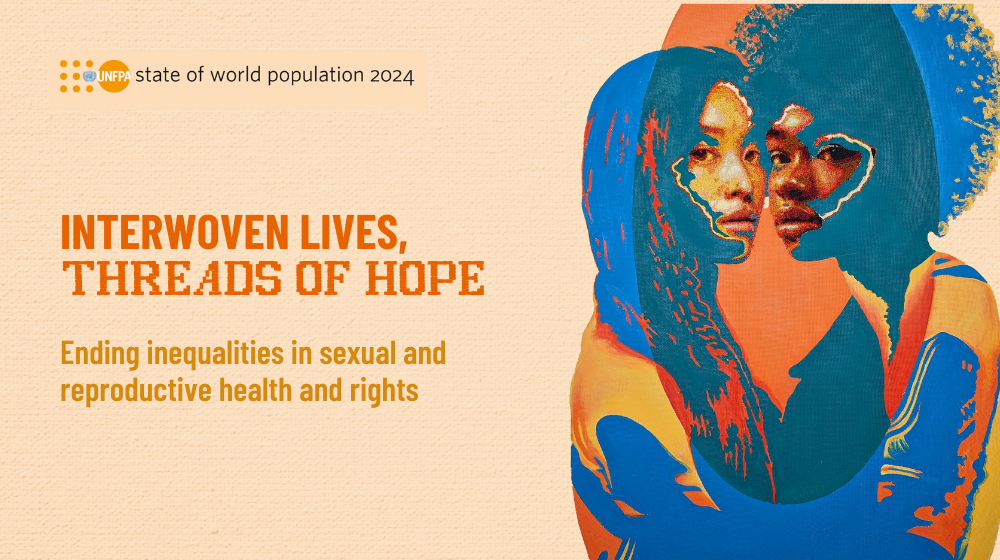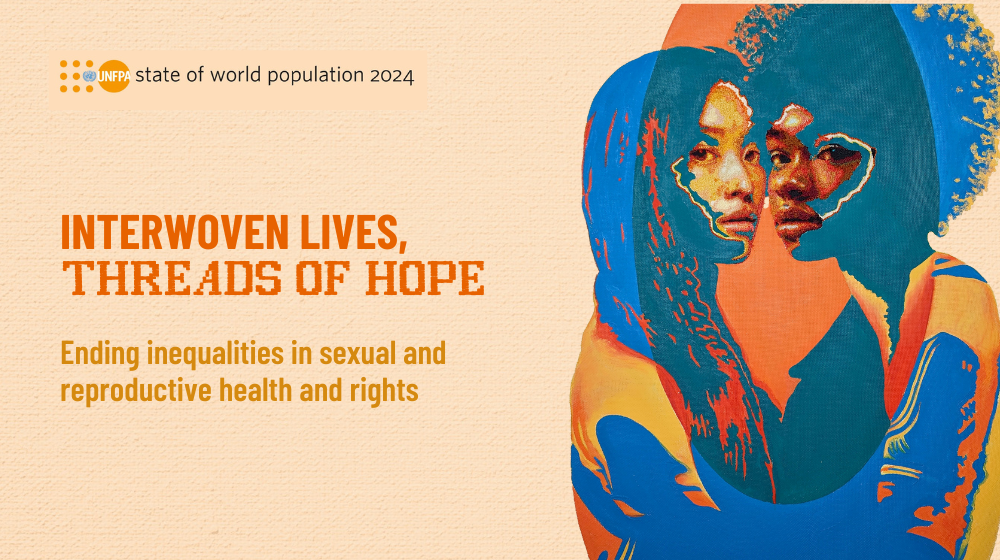Our world is more intertwined than ever before. Yet when we read the headlines, what do we see?
War. Polarization. Division. Fear.
These harsh messages are eroding faith in the one proven solution to the world’s greatest challenges: cooperation.
Humanity thrives on cooperation because our fates are woven together. We all share a common future.
Today, I am very pleased to present UNFPA’s flagship State of World Population report entitled Interwoven Lives, Threads of Hope: Ending inequalities in sexual and reproductive health and rights.
In it, we show that inequalities and inequities are widening. Human reproduction is being politicized. The rights of women, girls and gender-diverse people are the subject of increasing pushback.
And we ask you colleagues from the media, are the most vulnerable being left behind or, indeed, are they being pushed behind?
We can, and we must, push forward – together – because that is what works.
Global solidarity - that is how we reduced the unintended pregnancy rate by nearly 20 per cent since 1990 worldwide. That is how we reduced the maternal death rate by 34 per cent since the year 2000, and that is how we reduced new HIV infections by one third in the last 15 years.
In the last three decades, the proportion of women serving in parliaments across the world has more than doubled. We have secured laws against domestic violence in more than 160 countries.
That progress has taken place in this region too. Across Asia and the Pacific, people are living longer. It is safer for women to give birth and more possible for a girl to choose her life’s trajectory. With a reduction in child marriage, there has been a steady decline in adolescent pregnancy. For example, in 2000, there were 56 births per 1,000 young girls aged between 15 and 19 years old. In 2023, this figure dropped to less than 24 births per 1,000 young girls representing a 32 point decline over the last 23 years.
These are gains we achieved together. These are gains following the global agreement of our Member States at the International Conference on Population and Development in Cairo – 30 years ago – where governments agreed to ensure the reproductive health and rights of all people.
And since then, our capacity for global and regional collaboration has only grown.
New technologies allow for real-time information sharing. We have greater ability to collect and to process data. We know much more about the world and its needs – and, importantly, the solutions required.
At the same time, we see progress is slowing.
While there has been a over 60% reduction in maternal mortality in Asia and the Pacific since the year 2000, the bulk of the reduction was between 2000 and 2015. Since then, the region continues to struggle with high numbers of preventable maternal deaths.
Every hour, more than 6 women in our region die during pregnancy and childbirth. Less than 1 in 4 sexually active unmarried young people use contraception. On average, half the women in the Pacific Islands have been beaten, abused, or sexually violated by their intimate partner at least once in their lifetime.
So the question becomes: Why is this happening?
One important reason, our report shows, is that we are not effectively reaching those furthest behind.
We have seen, for example, that barriers to healthcare fell fastest for women who are more affluent, educated and privileged. In other words, we see that the groups that have benefitted the most are those that had the fewest barriers to begin with.
Access to modern contraceptives, for example, varies by many factors such as ethnicity, refugee and migration status, education, and location.
I saw this myself, a few months ago, when I visited a remote health clinic in a village in North Tarawa, Kiribati. I observed a nurse inject a woman with a contraceptive implant. Another lady stood over her, holding up a torch from her mobile phone. With such limited resources, anything could go wrong at any moment. But, this was their reality.
In the room next door, there were line markings drawn on the cement floor. They told me that these lines were indications of the slanting where the water would drain after the floor was washed – something they had to do often. Why? Because they deliver babies on the floor due to the lack of beds. I also visited the store room, where they did not have a refrigerator for cold supplies. For women living in such remote areas, how is it that we can do better to make sure they receive the care and attention they so desperately need and that they deserve?
Dear colleagues from the media,
Many of the findings in the report are the result of having better data than ever before. Thirty years ago, maternal mortality rates were only rough estimates. Today, data allows us to see clearly the unacceptable rates at which women are dying while giving life; data also show the inequalities that are quite literally killing them.
For example, a 15-year-old girl in the lowest-risk countries has a 1 in 23,000 risk of dying from pregnancy or childbirth. In the highest-risk countries, that is a 1 in 34 chance of dying. 1 in 23,000 versus 1 in 34.
And while there are vast inequalities and inequities between countries, our report finds that, in many cases, disparities in health access are even greater within countries.
Health systems are tainted by gender inequality, displacement, racial discrimination and misinformation.
For instance, in Asia and the Pacific, some 350 million women and girls live with disabilities, and those women are up to 10 times more likely to experience sexual abuse. Ten times, for our disabled women and girls.
Women from indigenous ethnic groups are less likely to receive antenatal care, less likely to give birth under the care of a skilled birth attendant, more likely to give birth as an adolescent and significantly more likely to die of causes related to pregnancy and childbirth.
Women and children are 14 times more likely to die than men during a disaster due to various factors that stem from existing inequalities.
Such inequalities are plain facts of life for millions of people across Asia and the Pacific, and indeed our world, sadly.
These inequalities should not be politicized or used as an accusation of bias; they should not be points of division that push people behind – rather they are and should be entry points for accelerating progress.
Because everywhere we look, we see gaps, and those gaps are widening. Stalling progress will turn into a reversal of progress.
Anxiety over higher fertility rates, low fertility rates and global migration is leading to xenophobia and turning women’s bodies into battlegrounds. Yet these trends – population growth in some places, population ageing in others, accelerating migration – are unlikely to change.
But we know what we can change.
We must redouble our efforts to achieve comprehensive, universal and inclusive health care, grounded in human rights and modern science. A medical revolution is under way, with telemedicine and self-care poised to remake health systems. This future requires that we equip people – from adolescents to doctors, midwives, to policymakers – with accurate and modern sexual and reproductive health information.
We need to collect more and better data, disaggregated by factors like ethnicity, disability and more, in order to understand who is being left behind and how to reach them. We must make sure the most vulnerable are visible, and that their rights are brought to the forefront.
These measures are not simply about reaching people at the margins. They are about strengthening all of us – the whole human tapestry, within Asia and the Pacific, and beyond.
Our report shows how investing in sexual and reproductive health benefits all of us.
Comprehensive sexuality education, ending gender-based violence, promoting gender equality and ending unmet need for contraception, these steps would contribute trillions of dollars to the global economy, and unleash gains in terms of education, productivity, workforce participation, and human well-being.
With Asia and the Pacific being home to half the world’s population, this region undoubtedly holds immense potential to unleash these gains.
We invite you, dear friends from the media, to take this message forward – help to hold countries accountable for the promise made thirty years ago to place people’s sexual and reproductive health and choices at the center of population policies. Be a voice for the voiceless by sharing the stories of vulnerable communities through ethical and evidence based reporting.
We have made incredible progress by working together, and we must continue to advance towards a world of rights and choices for all – by pushing forward those left behind. Global soladiary is key. No exceptions. No exclusions.
Thank you all very much for being here.




